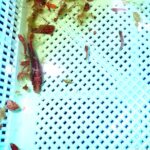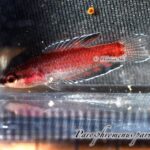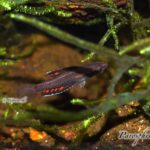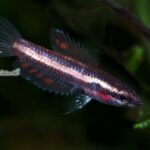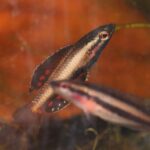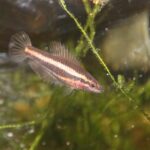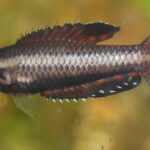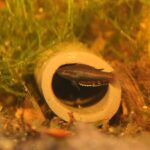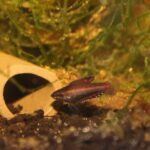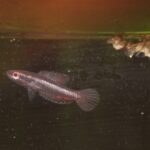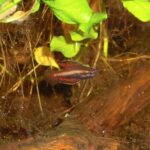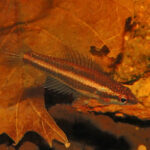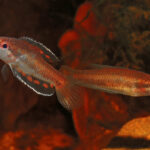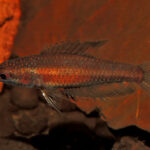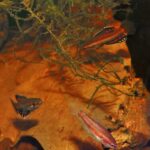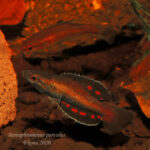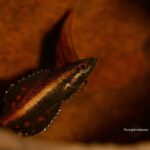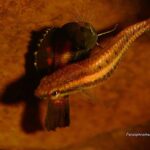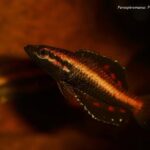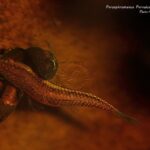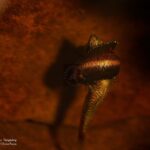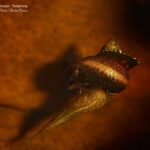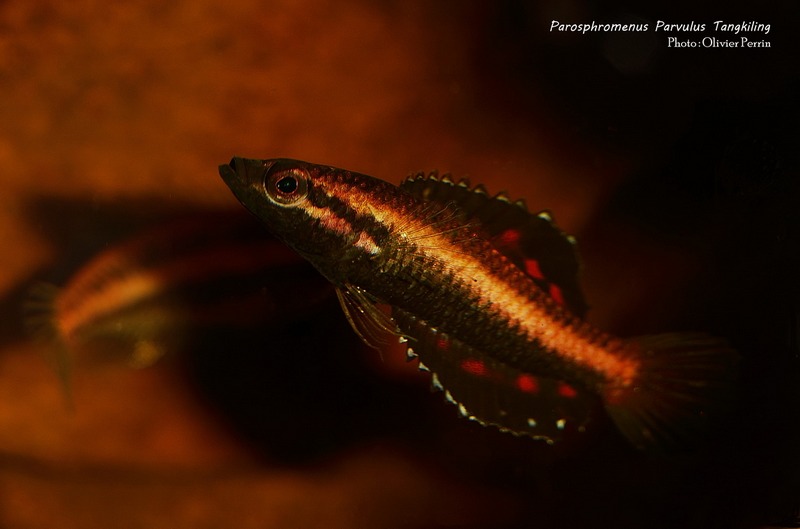
First description: Ein neuer Labyrinthfisch von Borneo – Parosphromenus parvulus nov. spec. Das Aquarium 13 (120):247-250.
Characteristics: total length max. 3.5 cm. Dorsal structure: X-XI, 5-6, total 15-17, anal fin: VIII-IX, 10-11, total 18-20. Much leaner, with a less high back compared to the other species, with the exception of P.ornaticauda, which can be regarded as a “twin species”. Adults appear to have a wide, rather then high, oval cross-section, seen from the front. Like ornaticauda it differs also in behaviour and coloration. The ♂ shows characteristic, nagyi-like body coloration in breeding colouration: lower half of the body very dark to black, upper half yellow to yellow-brown. Also the patterns of the unpaired fins differ, like those of P.ornaticauda, from the typical patterns in this species: dorsal and anal fin are black with red spots.
Depending on the locality, there are various degrees of very luminous white iridescent edges. The ventral fins are transparent, the caudal fins are almost colourless or dark-blackish. Nuptial colouration is shown often, but not as continuously as by P.ornaticauda. The species-typical striped patterns can be seen sometimes in sexually mature males, but mainly in transition to breeding colours. The female shows the striped patterns most of the time, and unlike ornaticauda, never an appearance which is almost identical with the nuptial colours of the male. Regarding variation within of the species, please refer to “Distribution/Occurrence”.
Similar species: in males confusion is not possible; it can be distinguished by colour and patterns from the structurally similar species P.ornaticauda In females in normal dress, the fish can be confused with P.ornaticauda. Small fry are almost indistinguishable. Due to the body structure, the risk of confusion with other species of licorice gouramis is low.
Occurrence / Distribution: Southern Central Borneo: Kalimantan Tengah, in the area of Banjarmasin. First discovery took place 250km NW of this city near Palangan in the catchment area of the Mentaya-River. Later ex peditions have shown that the species has a much wider distribution thanwas assumed. So it was found by H. Linke and J. Knüppel in 1988 in Palangkaraya; it was already clear then that the area of occurrence is much bigger as originally thought. Later further localities were found, among others by Linke and O. Perrin. Thus P.parvulus turned out to be the licorice gourami with the (so far) largest known area of distribution.
However the fish caught there showed a small but significant variation, especially concerning the patterns of the fins. So the fish from the vicinity of Tangkiling had the clearest white luminous edges in dorsal and anal fin and also a significant red dot pattern mainly in the dorsal fin, while the population, existing near Babugus has a more modest colouration (both collected by H. Linke).
Threat: Even P. parvulus is highly endangered today by relentless destruction of its habitats, despite the fact that more locations are known than at the time of its discovery. While some of the older localities have already disappeared, many of the latterly discovered places have become more or less affected by human activities. The ongoing progress of forest destruction increasingly threatens formerly unaffected remaining wetlands, which are prone to transformation to short-term use as farmland.
Discovery/First import:discovered near Palangan andbrought to Europe by Edith Korthaus and Dr. Walter Foersch in 1978. The first description was made in Germany in connection with this first import.
Trade:before 2005 P. parvulus was not seen in trade at all. The few fish, which were then in the aquarium stock, originated from private imports or were bred from these. From 2006 onwards, some exports or imports were known and meanwhile this species is sometimes available in trade. Compared to ornaticauda it is only offered in small numbers in pet shops, but – because the fish is very unimpressive there – they are doomed even faster then its twin species.
Care / Breeding: concerning care the fish differs little from P.ornaticauda, but sometimes it seems to be less precarious. However, breeding this species is still a mystery, as reliable breeding (and caring) couples are not the rule. Also this species prefers caves with a small diameter, in which they can lay their often small clutches (8 – 25 eggs). Also for parvulus a low germ density is the prerequisite for the survival of the eggs. For this reason breeding success has often occurred only after a drop of the pH value to 4 or even less. G. Kopic reports of breeding success at pH 2.7. But this experiment should not be repeated without any good reason. Kopic also reports that larvae had difficulties freeing themselves from the egg shells. This is why artificial breeding without the caring male poses even more risk than it usually does. With natural care by the male at higher pH values, complete clutches often disappear overnight, but there have been successful broods at pH 6.0 and more. Low germ density often, but not always, corresponds with low pH values. Also the conductivity has to be low, preferably below 35 microSiemens/cm, because otherwise the clutches would not stick to the caves’ ceilings, and the eggs would fall down and perish. Like P.ornaticauda, P. parvulus is not a beginner’s fish.
Behaviour / Particularities:like its twin species, P.parvulus performs a head-up courtship. Caves are accepted at the bottom, near the surface or in suitable positions at any place in the plant layers. Also here, as for its twin species, the area of its activity is much greater than other licorice gouramis, because the P.parvulus male does a spectacular courtship dance, which we have already described for the other species: first the male presents its fluttering fin edges and then zig-zags around a female. However the striking colour approximation of the females to the male´s nuptial plumage, which can be recognised during the courtship behaviour of P.ornaticauda, does not take place with P.parvulus. Still, both species stand out clearly as twins within the genus, due to their structural and behavioural particularities. Eventually they may form a special group, together with the slim form of P.sumatranus, which would indicate an evolutionarily closer relationship.
Parosphromenus parvulus ‘Tangkiling’ photographed by Olivier Perrin
Parosphromenus parvulus ‘Tangkiling’ photographed by Olivier Perrin.





